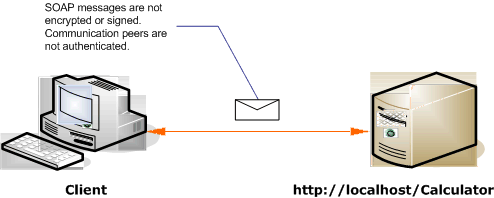Serviço e cliente de internet desprotegido
A ilustração a seguir mostra um exemplo de um cliente e serviço público e não protegido do WCF (Windows Communication Foundation):

| Característica | Descrição |
|---|---|
| Modo de segurança | Nenhum |
| Transport | HTTP |
| Associação | BasicHttpBinding no código, ou o elemento <basicHttpBinding> na configuração. |
| Interoperabilidade | Com serviços e clientes de serviços Web existentes |
| Autenticação | Nenhum |
| Integridade | Nenhum |
| Confidencialidade | Nenhum |
Serviço
O código e a configuração a seguir devem ser executados independentemente. Realize um dos seguintes procedimentos:
Crie um serviço autônomo usando o código sem configuração.
Crie um serviço usando a configuração fornecida, mas não defina nenhum ponto de extremidade.
Código
O código a seguir mostra como criar um ponto de extremidade sem segurança. Por padrão, BasicHttpBinding tem o modo de segurança definido como None.
Uri httpUri = new Uri("http://localhost/Calculator");
// Create the ServiceHost.
ServiceHost myServiceHost = new ServiceHost(typeof(Calculator), httpUri);
// Create a binding that uses HTTP. By default,
// this binding has no security.
BasicHttpBinding b = new BasicHttpBinding();
// Add an endpoint to the service.
myServiceHost.AddServiceEndpoint(typeof(ICalculator), b, "");
// Open the service and wait for calls.
AddMexEndpoint(ref myServiceHost);
myServiceHost.Open();
Console.Write("Listening....");
Console.ReadLine();
// Close the service when a key is pressed.
myServiceHost.Close();
Dim httpUri As New Uri("http://localhost/Calculator")
' Create the ServiceHost.
Dim myServiceHost As New ServiceHost(GetType(Calculator), httpUri)
' Create a binding that uses HTTP. By default,
' this binding has no security.
Dim b As New BasicHttpBinding()
' Add an endpoint to the service.
myServiceHost.AddServiceEndpoint(GetType(ICalculator), b, "")
' Open the service and wait for calls.
AddMexEndpoint(myServiceHost)
myServiceHost.Open()
Console.Write("Listening....")
Console.ReadLine()
' Close the service when a key is pressed.
myServiceHost.Close()
Configuração de Serviço
O código a seguir configura o mesmo ponto de extremidade usando a configuração.
<?xml version="1.0" encoding="utf-8"?>
<configuration>
<system.serviceModel>
<behaviors />
<services>
<service behaviorConfiguration="" name="ServiceModel.Calculator">
<endpoint address="http://localhost/Calculator"
binding="basicHttpBinding"
bindingConfiguration="Basic_Unsecured"
name="BasicHttp_ICalculator"
contract="ServiceModel.ICalculator" />
</service>
</services>
<bindings>
<basicHttpBinding>
<binding name="Basic_Unsecured" />
</basicHttpBinding>
</bindings>
<client />
</system.serviceModel>
</configuration>
Cliente
O código e a configuração a seguir devem ser executados independentemente. Realize um dos seguintes procedimentos:
Crie um cliente autônomo usando o código (e o código do cliente).
Crie um cliente que não defina nenhum endereço de ponto de extremidade. Em vez disso, use o construtor do cliente que usa o nome da configuração como um argumento. Por exemplo:
CalculatorClient cc = new CalculatorClient("EndpointConfigurationName");Dim cc As New CalculatorClient("EndpointConfigurationName")
Código
O código a seguir mostra um cliente WCF básico que acessa um ponto de extremidade não seguro.
// Create an instance of the BasicHttpBinding.
// By default, there is no security.
BasicHttpBinding myBinding = new BasicHttpBinding();
// Create the address string, or get it from configuration.
string httpUri = "http://localhost/Calculator";
// Create an endpoint address with the address.
EndpointAddress myEndpoint = new EndpointAddress(httpUri);
// Create an instance of the WCF client. The client
// code was generated using the Svcutil.exe tool.
CalculatorClient cc = new CalculatorClient(myBinding, myEndpoint);
try
{
cc.Open();
// Begin using the calculator.
Console.WriteLine(cc.Divide(100, 2));
// Close the client.
cc.Close();
}
catch (TimeoutException tex)
{
Console.WriteLine(tex.Message);
cc.Abort();
}
catch (CommunicationException cex)
{
Console.WriteLine(cex.Message);
cc.Abort();
}
finally
{
Console.WriteLine("Closed the client");
Console.ReadLine();
}
' Create an instance of the BasicHttpBinding.
' By default, there is no security.
Dim myBinding As New BasicHttpBinding()
' Create the address string, or get it from configuration.
Dim httpUri As String = "http://localhost/Calculator"
' Create an endpoint address with the address.
Dim myEndpoint As New EndpointAddress(httpUri)
' Create an instance of the WCF client. The client
' code was generated using the Svcutil.exe tool.
Dim cc As New CalculatorClient(myBinding, myEndpoint)
Try
cc.Open()
' Begin using the calculator.
Console.WriteLine(cc.Divide(100, 2))
' Close the client.
cc.Close()
Catch tex As TimeoutException
Console.WriteLine(tex.Message)
cc.Abort()
Catch cex As CommunicationException
Console.WriteLine(cex.Message)
cc.Abort()
Finally
Console.WriteLine("Closed the client")
Console.ReadLine()
End Try
Configuração do cliente
O código a seguir configura o cliente.
<?xml version="1.0" encoding="utf-8"?>
<configuration>
<system.serviceModel>
<bindings>
<basicHttpBinding>
<binding name="BasicHttpBinding_ICalculator" >
<security mode="None">
</security>
</binding>
</basicHttpBinding>
</bindings>
<client>
<endpoint address="http://localhost/Calculator/Unsecured"
binding="basicHttpBinding"
bindingConfiguration="BasicHttpBinding_ICalculator"
contract="ICalculator"
name="BasicHttpBinding_ICalculator" />
</client>
</system.serviceModel>
</configuration>